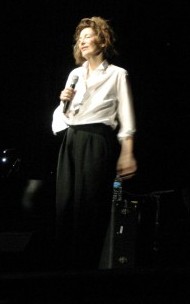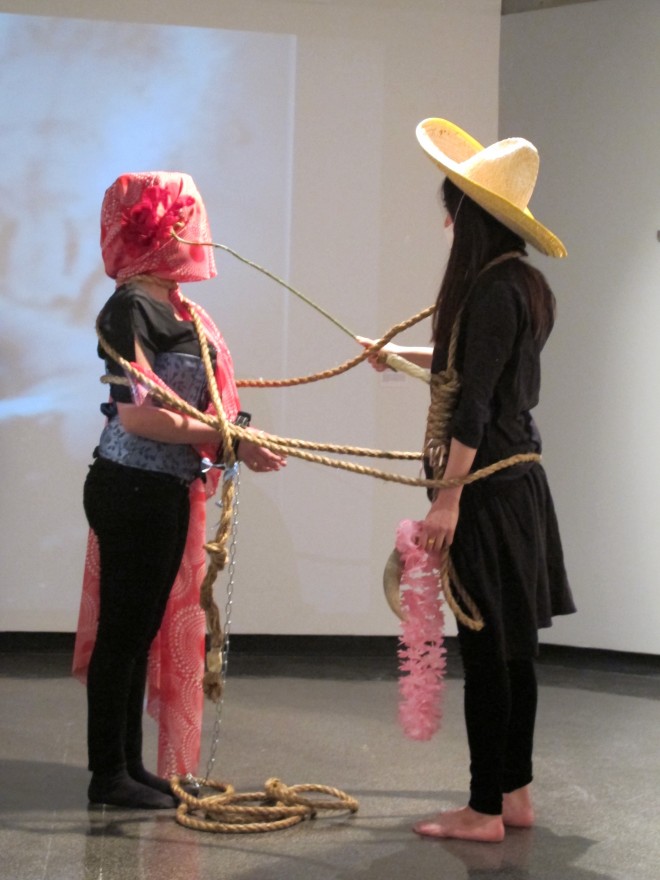
There are great love stories and then there’s the story of Jane Birkin and Serge Gainsbourg.
Serge Gainsbourg was a popular singer, songwriter and film director until his death in 1991; Jane Birkin was (and still is) a fashion model, actress, singer and muse. If you’ve ever thumbed-through the pages of Vogue, you know that one of the coveted Hermès handbags is named in her honor — the so-called “Birkin Bag”. The two met in 1968 and were together until 1980, when Madame left Monsieur. They maintained a professional relationship until Gainsbourg’s death in 1991.
Why is this important? Birkin was at the Portage Theater on Monday night for “Serge Gainsbourg and Jane via Japan”, an international tour that commemorates the 20-year anniversary of Gainsbourg’s death. “I wanted to share Gainsbourg with the world,” she told an elated crowd.
There were no opening acts, no high-tech sets or complicated lighting patterns. The lights dimmed and the band came on stage, and then slowly, Birkin sang her way to the front, wearing a casual outfit of a loose-fitting white shirt (sleeves rolled up, first five buttons undone), and a relaxed pair of black trousers — one part Mick Jagger and one part Marlene Dietrich, with a dash of Edith Piaf as she looked up into the lights. Her voice is light and rolls over the French lyrics like a speedboat going over whitecaps on the sea. The music stops and Jane Birkin pauses and smiles at the audience. They are older, but captive, and go wild at her gap-toothed smile. The band starts up again and she launches in to another classic Gainsbourg song.

“Baby Alone in Babylone” was written for her after she left Gainsbourg for Jacques Doillon. The song is voiced by a gruff French man bemoaning the loss of his love with the inevitable disappointment of an existentialist. After that comes “Les Amours Feintes”, the last song Gainsbourg wrote for Jane before he passed away. “‘Feintes’”, says Birkin, “means both ‘feigned’ and ‘dead’, so the song means both ‘feigned love’ and ‘love of the dead.” Birkin’s performance of the song says much about her feelings towards Gainsbourg; this was not the performance of a woman publicly mourning her lover, but the story of a friendship between two artists and performers.
Birkin kept the drama out of her performance, which supplied the story on its own. She paused midway through the show to explain why she was on this particular tour. (Birkin has been working consistently, if somewhat quietly, since the late ’60s.) Her band, she explained, was comprised of Japanese musicians who had been affected by the earthquake and tsunami earlier this year. “I want to keep that horrible event in the public memory here,” she explained., Birkin also encouraged the audience to donate money for children’s charities in Japan on their way out.
Birkin touched on some of Gainsbourg’s greatest hits, including “La Chanson de Prévert”, “Les Amours Perdues” and “Mon Amour Baiser” (a play on the French double entendre for kiss/fuck). She also sang “Ballade de Melody Nelson” which she noted was very unsuccessful when it was released in 1971 but was now the favorite album amongst the indie music set, like Beck and Rufus Wainwright.
The audience — a motley assortment of cultured families, Francophillic hipsters and the 50-something jazz crowd — regarded Birkin with the sort of adoration that befits a performer of her caliber, applauding wildly whenever she came and sat on the front of the stage, and snapping hundreds of photos when she leaped off the stage and came down to sing amongst the audience. After introducing her musicians, she bowed gracefully and left the stage. After one encore, where she performed “Ces Petits Riens” and “Les Dessous Chics”, Birkin bowed humbly before her ecstatic audience and retreated back stage.
While Birkin may not have the epic affect of Leonard Cohen or Neil Young in concert, her commitment to the history of her music, her friendship with Gainsbourg and her stature as an entertainer shone through.







